A-36 Apache dive bomber! Now is that a Mustang or not?
At first sight the A-36 Apache looks like a representative of those early P-51 Mustang variants that were still powered by the American Allison engine. I would like to claim that even a second look will only produce few doubts to have a "Mustang" in front of you. Before a third look is risked, I would like to throw some light on the origin of the designation A-36 Apache.
Like every good story, the genesis of the P-51 Mustang does not run in a straight line - and the dramaturgy also knows the figure of the outsider, who against all expectations becomes a hero: N.A:A., "North American Aviation", at the time when a British procurement committee commissioned the design and construction of a fighter plane for the RAF, could only refer to scarce experience in the construction of single-engine aircraft - and literally none in the design of modern fighters. The original plan of the British was to order the production of a more powerful P-40 from the renowned manufacturer Curtiss. It was only after intensive negotiations, however, that N.A.A. was convinced to go for a completely new design.
The following unbelievably short and successful development of the NA-73X design towards the Mustang has written itself into history. One aspect of this amazing development is also the long lasting disinterest of USAAC in the superior fighter plane.
However, North American was not satisfied with this. After in contemporary Europe the "Blitzkrieg" seemed to confirm the concept of the dive bomber, the responsible persons decided to jump on this bandwagon: the Mustang I built for the British was further developed to a dive bomber by adding bomb locks and the installation of hydraulically operated dive brakes and was offered again to USAAC in this form.
Still uninterested in a new fighter, the Army Air Corp did not want to close its mind to a Stuka: In June 1942, a development contract was signed with NAA, which led to the delivery of the first aircraft to training units as early as autumn of that year. The official type designation for the new type was "A-36 Apache", but the name "Mustang", which was given by the British, was already so well known that it was used at the same time. After all good things come in threes, the name "Invader" should also be mentioned here, which accompanied the A-36 for some time. It was the result of a remark of a combat pilot to the press, it was in the news for some time, but finally it could not prevail over the official name.
The A-36 made its military debut in North Africa in May 43, where the 27th Bombardement Group (Light) and the 86th Bombardement Group (Dive) introduced the new design. For about a year the Apache and their pilots were able to gain an excellent reputation over Africa, Sicily and Italy before the units were converted. P-40 and P-47 replaced the A-36 in the fighter-bomber role and as a dive fighter, the surviving A-36s were transferred to training units.
Another arena where the Apache was able to prove its qualities was the theatre of war in India and Burma; the RAF also flew a few A-36s, which were mainly used here by reconnaissance units. A total of about 500 were produced.
My model shows a particularly interesting and photographically well documented A-36, which was flown by the 112th BS, 86th BG from the Algerian base Tafaraoui in summer 1943. A e special feature here are the two names "Herschel IV" and "Dotsie" as well as a possible marking with US flags on the tail unit, which was briefly used. I would have liked to implement this on the model! Why this did not happen, I will explain a little later.
My model was created from the Italeri kit, which presents the now older Accurate Miniatures shapes together with new marking variants in the form of a large and usable decal sheet.
The construction itself was relaxed. Whoever knows Accurate Miniatures shapes knows how convincing they can be in terms of accuracy of fit and excellent detailing. At the same time, the complexity in detail is combined with a rather simple part construction, which ensures a fast progress.
On the minus side I have noted that a certain caution is advisable regarding the fidelity of some kit shapes. I am thinking here especially of the representation of all MG barrels included in the kit, those in the nose are wrong in shape, as they run out to a strange tip, while the four MGs in the wings are shown with a covering, for which I have not found any models. The decision to replace these parts was additionally made easier by a completely blurred representation of the cooling jackets: the parts were replaced from a Brassin set by Eduard.
Etched parts can also be found in the representation of the seatbelts in the cockpit and the small propellers of the bomb fuses. I also replaced the pitot tube and the hydraulic lines on the landing gear and built them from wire myself.
After I wanted to represent a strongly stressed surface, the surface color was built up in several layers, which were partly covered with dabbed-on Maskol. This results in a worn and abraded overall impression of the paint, which is quite good for the job.
Although the decals are printed on a relatively thick carrier film, they can be used very well with appropriate pre- and post-treatment with glossy clear varnish. As often there is an exception that confirms the rule: the two US flags intended for the tail unit turned out to be such a "thick carpet" on the finely formed structures of the stern that I finally let the variant without "stars and stripes" come into play.
In conclusion I may say that I experienced this construction as a positive surprise. I did not expect such a quality of detail and at the same time an uncomplicated construction! The A-36 Apache now enriches the growing "mustang herd" in the showcase to my satisfaction. I would like to warmly recommend this kit to everyone who would also enjoy it.
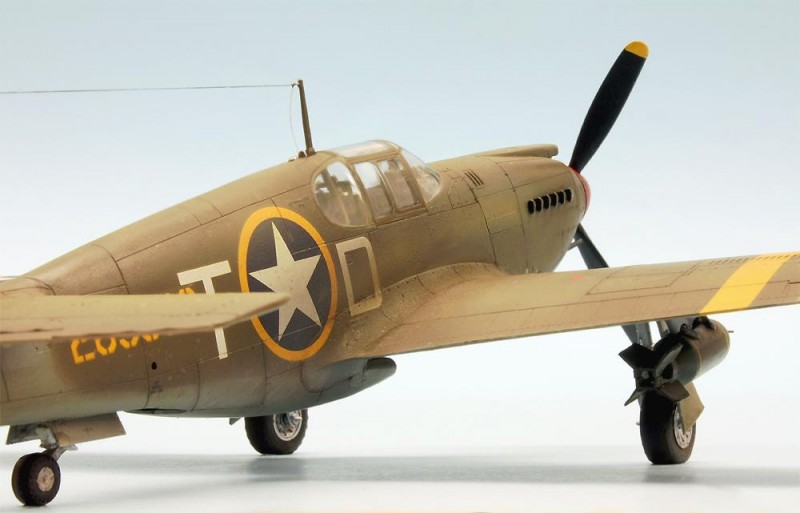
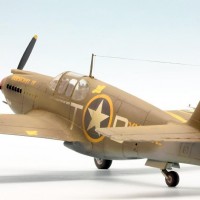
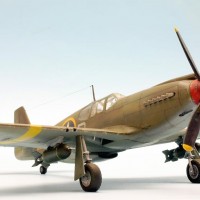
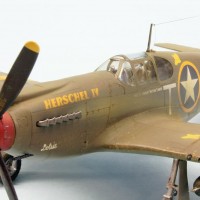
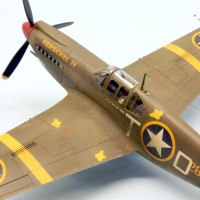
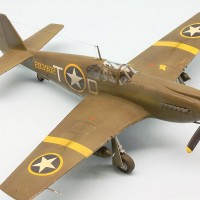
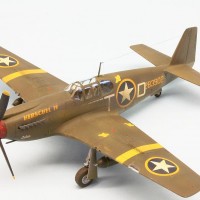
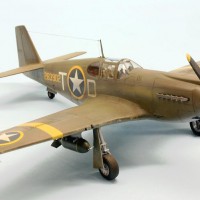
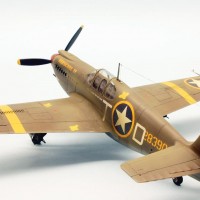
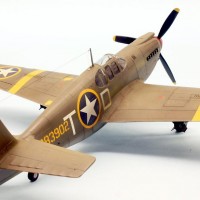
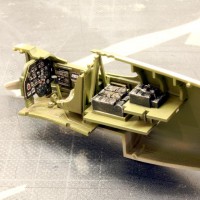
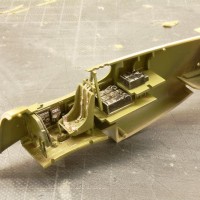

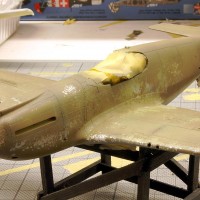
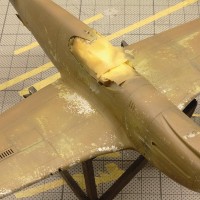
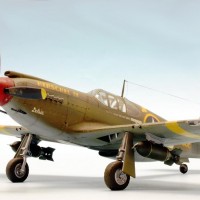
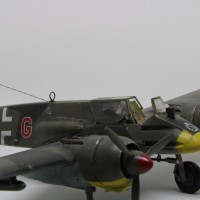
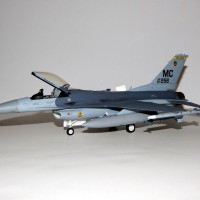
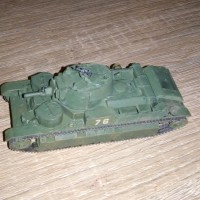
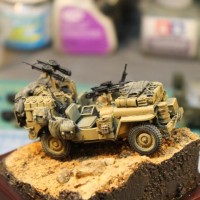
Well done Roland, I've build several of the Accurate Miniature kits and have always enjoyed building them. I like it.
Nice job! Even though it's a well weathered finish it's not garishly overdone. She looks the part.
Well built model and excellent photos, a winning combo.
Stunning! Just the right amount of war torn wear and colorful markings to attract the eye and draw it in to a high quality build. Nice work.
Beautiful Roland! As others stated, she looks worn but not overly so. I love the OD look, and the subtle whether employed. Had I not built my Italeri A-36 for the teeth and fangs GB, I'd have built Herschel as you have, as I think it's a great scheme (with or without the flag). Thankfully I have an AM kit in the stash, and they may yet be used.
To the point of your discussion about the name, I'm in the camp that this is a Mustang. Interesting read below: http://www.thehangardeck.com/news/2019/3/16/the-a-36-by-any-other-name
Worth noting too that the USAF Museum has changed the placard on their A-36 from "Apache" to "Mustang" in the past few years.
Very well done OD Roland, thumbs up!
Excellent work!
Good looking A-stang! Great colour combination with the red spinner. I kind of like the slightly different nose profile and the 3 bladed prop, makes it look a bit more noble than the rawish 4 bladed job.
Beautiful work. I like it a lot. Very much up to your usual standard of excellence.
You are right that North American had no experience building fighters, but when the company got started, President "Dutch" Kindelberger decided they would go "low end" and compete for trainers, where they could get experience with the latest and newest airframe design and construction techniques - the result was the Yale/Harvard/Texan series, probably the best trainers of the period, all of which were "state of the art" in design.
Kindelberger also used every edge to get access to new knowledge. Edgar Schmued had been the first US designer to study a captured Bf-109 - Kindelberger arguing that he was the one in closest touch with German developments from his background and continuing contacts in the German aviation industry. As Schmued said in an interview I did with him in 1981: "Yes, the P-51 was designed and built in 120 days, but I had been working on such a design on my own for several years."
So that is how the P-51 came to be as advanced as it was.
Really like the well worn look. These kits are great fun to build.
This is a beautiful fighter bomber, and your work is outstanding. Thanks for sharing it with us. I have built a few of these AM early Mustangs, and I really like how yours is finished. You did a fine job with it. I like these Accurate Miniatures models. They really packed a lot of details into each kit they manufactured.
I was very fortunate to be around the Collings Foundation A-36 as it was being restored. They ended up painting theirs as "Baby Carmen" from the 86th Fighter Group. It's a beautiful plane, and they won the Golden Wrench award at Oshkosh with it the year they finished it up. Here's a few pictures I took of it during the restoration. You can see the Mustang heritage from any angle...
Terrific job, Roland. I especially like the worn finish. Some things never go out of style, Mustangs (Apaches, included), and quality workmanship...I see both here.
Typical excellent work, Roland. Beautifully built machine and a very interesting story that, for the most part, I was not aware of. I've got the original AM kit, now I have a very strong motivation to start it.
All the best!
Looks great! Love the Mustang - in all it's permutations...
It is more than overdue that I say thank you all very much! Your reactions are not only so friendly but also motivating - and highly interesting!
One of the most impressive benefits here at IModeler is that real experts and people who have experienced so many amazing things have their say.
In this sense special thanks to Tom Cleaver and Louis Gardner for their contributions!
To Andrew H ... I'm glad to see that you've read my article on The Hangardeck. I'm also the guy who proudly states that he's the guy who contacted the Curator of the USAF Museum and began their verification of my documents (from the USAAF and NAA) and the end result was that they changed the signage on their A-36A from "Apache" to "Mustang" (with a notation about "Apache" and "Invader" being "nicknames" in the smaller print below the designation and official name.
Right after my article came out in March, 2019, the then-historical archivist at Boeing, knowing of my personal research in the A-36 and other Mustang history, sent me scans of two important documents that further "nailed" the Mustang name for the A-36 (not that they were needed to verify that name with me).
I'm trying to help put the "Apache" name for the A-36 "away forEVER!" and they helped-a lot!